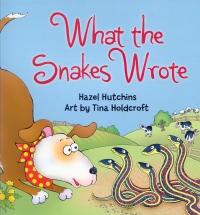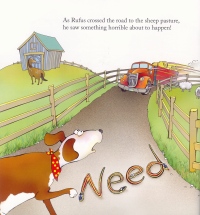| ________________
CM . . .
. Volume XX Number 4. . . .September 27, 2013
excerpt:
What the Snakes Wrote is a story about a group of garter snakes who find their winter den under threat. The snakes band together to appeal to Rufus the dog for help, and although Rufus does not really understand what the snakes want from him, he does recognize that the snakes are trying to tell him something important (by twisting their bodies into words), and so Rufus works to get the farmer involved. This proves more difficult than Rufus expects, and he must try a number of times to get the farmerís attention in order to find out what the snakes need. Once Rufus finally gets the farmer to see the message from the snakes, the farmer realizes that he was about to destroy their winter den and must instead find a way to save it.
On occasion, the text of the book can seem a little awkward or basic, but it is aimed at young children, and the book ends with two pages of great facts about garter snakes and their habits. These two pages are a wonderful addition to the story as their contents will answer many of the questions the book will likely generate for its readers. The fact pages also remind readers that, ďof course, snakes canít write!Ē which is important for clarity, especially since the book is mostly fact-based and admits that Rufus cannot actually read the messages from the snakes. Consequently, bringing the story back to reality is important. What the Snakes Wrote would be a good purchase for most libraries, but its contents may particularly resonate with libraries in Manitoba where school field trips to the Narcisse Snake Pits are common for elementary schools. Recommended. Carla Epp is a librarian with Winnipeg Public Library in Winnipeg, MB.
To comment
on this title or this review, send mail to cm@umanitoba.ca.
Copyright © the Manitoba Library Association. Reproduction for personal
use is permitted only if this copyright notice is maintained. Any
other reproduction is prohibited without permission.
NEXT REVIEW | TABLE OF CONTENTS FOR THIS ISSUE
- September 27 2013.
AUTHORS |
TITLES |
MEDIA REVIEWS |
PROFILES |
BACK ISSUES |
SEARCH |
CMARCHIVE |
HOME |

 The cartoon illustrations in this story are very entertaining. The expressions on the animalsí faces are often quite funny, and the focus is kept on the animals. The reader does not see anything human but the farmerís legs until the very end of the story. It is also fun that some of the text is only available in the illustrations, instead of being repeated in the text and pictures, as often happens in picture books.
The cartoon illustrations in this story are very entertaining. The expressions on the animalsí faces are often quite funny, and the focus is kept on the animals. The reader does not see anything human but the farmerís legs until the very end of the story. It is also fun that some of the text is only available in the illustrations, instead of being repeated in the text and pictures, as often happens in picture books.